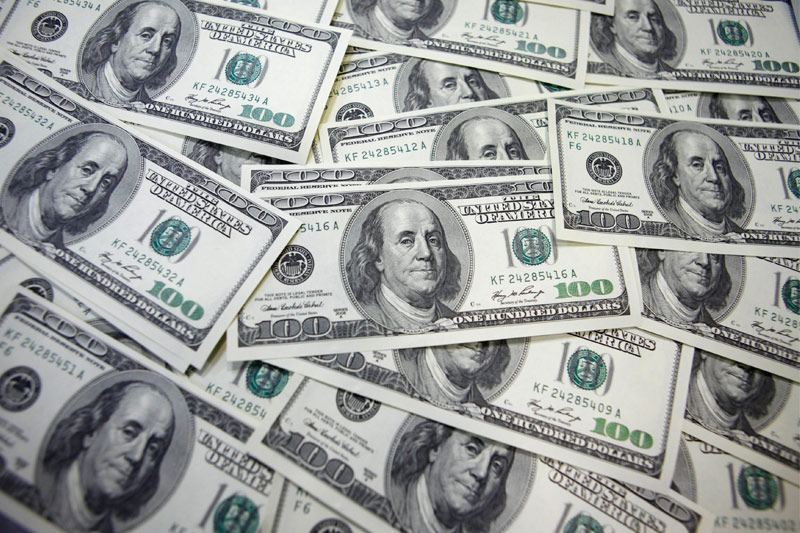Investing.com - The U.S. dollar dipped lower against its major counterparts on Thursday, following the release of weak U.S. employment data, but sustained concerns over rising Spanish and Italian borrowing costs supported demand for the safety of the greenback.
During European afternoon trade, the dollar was lower against the euro, with EUR/USD adding 0.12% to hit 1.2571.
The U.S. Department of Labor said the number of people who filed for unemployment assistance in the U.S. last week unexpectedly increased to 386,000, against expectations for a decline of 5,000 to 375,000.
The previous week’s figure was revised up to 380,000 from a previously reported 377,000.
A separate report showed that U.S. consumer price inflation rose 0.2% in May, bringing the annualized rate of inflation to 2.3%, broadly in line with expectations.
But the euro’s gains were capped as the yield on Spanish 10-year bonds was at 6.98%, after briefly rising above the critical 7% threshold earlier, a level seen as unsustainable in the long run.
On Wednesday, ratings agency Moody’s cut Spain’s credit rating by three notches to just above junk status and warned that further cuts were possible, fuelling fears over the crisis in the country’s banking sector.
Earlier Thursday, Italy sold the maximum targeted amount of EUR4.5 billion of government bonds, but the country’s three-year borrowing costs jumped to the highest level since December, amid concerns over sovereign debt contagion.
Sentiment on the euro also remained fragile ahead of Sunday’s closely watched general election in Greece, amid fears that a win for anti-bailout parties could precipitate a Greek exit from the euro zone.
The greenback was lower against the pound, with GBP/USD rising 0.20% to hit 1.5536.
Elsewhere, the greenback was lower against the yen and the Swiss franc, with USD/JPY shedding 0.26% to hit 79.26 and USD/CHF losing 0.13% to hit 0.9551.
The Swiss National Bank held its benchmark interest rate at 0.0% following its policy meeting earlier and reiterated that it was prepared to buy foreign currency in unlimited quantities in order to enforce the 1.20 minimum exchange rate imposed on the euro in September.
The greenback was weaker against its Canadian, Australian and New Zealand counterparts, with USD/CAD shedding 0.46% to hit 1.0253, AUD/USD climbing 0.35% to hit 0.9965 and NZD/USD jumping 0.95% to hit 0.7796.
Earlier in the day, the Reserve Bank of New Zealand maintained its benchmark interest rate at 2.50%, citing a deteriorating global economic outlook.
The dollar index, which tracks the performance of the greenback versus a basket of six other major currencies, slipped 0.08%, to trade at 82.52.
Also Thursday, official data showed that the U.S. current account deficit widened more-than-expected in the first three months of 2012, posting the largest the largest deficit since the fourth quarter of 2008.
The U.S. Bureau of Economic Analysis said the country’s current account deficit widened to a seasonally adjusted USD137.3 billion in the first quarter, from a revised deficit of USD118.7 billion in the previous quarter.
Analysts had expected the U.S. current account deficit to widen to USD132.3 billion.
During European afternoon trade, the dollar was lower against the euro, with EUR/USD adding 0.12% to hit 1.2571.
The U.S. Department of Labor said the number of people who filed for unemployment assistance in the U.S. last week unexpectedly increased to 386,000, against expectations for a decline of 5,000 to 375,000.
The previous week’s figure was revised up to 380,000 from a previously reported 377,000.
A separate report showed that U.S. consumer price inflation rose 0.2% in May, bringing the annualized rate of inflation to 2.3%, broadly in line with expectations.
But the euro’s gains were capped as the yield on Spanish 10-year bonds was at 6.98%, after briefly rising above the critical 7% threshold earlier, a level seen as unsustainable in the long run.
On Wednesday, ratings agency Moody’s cut Spain’s credit rating by three notches to just above junk status and warned that further cuts were possible, fuelling fears over the crisis in the country’s banking sector.
Earlier Thursday, Italy sold the maximum targeted amount of EUR4.5 billion of government bonds, but the country’s three-year borrowing costs jumped to the highest level since December, amid concerns over sovereign debt contagion.
Sentiment on the euro also remained fragile ahead of Sunday’s closely watched general election in Greece, amid fears that a win for anti-bailout parties could precipitate a Greek exit from the euro zone.
The greenback was lower against the pound, with GBP/USD rising 0.20% to hit 1.5536.
Elsewhere, the greenback was lower against the yen and the Swiss franc, with USD/JPY shedding 0.26% to hit 79.26 and USD/CHF losing 0.13% to hit 0.9551.
The Swiss National Bank held its benchmark interest rate at 0.0% following its policy meeting earlier and reiterated that it was prepared to buy foreign currency in unlimited quantities in order to enforce the 1.20 minimum exchange rate imposed on the euro in September.
The greenback was weaker against its Canadian, Australian and New Zealand counterparts, with USD/CAD shedding 0.46% to hit 1.0253, AUD/USD climbing 0.35% to hit 0.9965 and NZD/USD jumping 0.95% to hit 0.7796.
Earlier in the day, the Reserve Bank of New Zealand maintained its benchmark interest rate at 2.50%, citing a deteriorating global economic outlook.
The dollar index, which tracks the performance of the greenback versus a basket of six other major currencies, slipped 0.08%, to trade at 82.52.
Also Thursday, official data showed that the U.S. current account deficit widened more-than-expected in the first three months of 2012, posting the largest the largest deficit since the fourth quarter of 2008.
The U.S. Bureau of Economic Analysis said the country’s current account deficit widened to a seasonally adjusted USD137.3 billion in the first quarter, from a revised deficit of USD118.7 billion in the previous quarter.
Analysts had expected the U.S. current account deficit to widen to USD132.3 billion.
